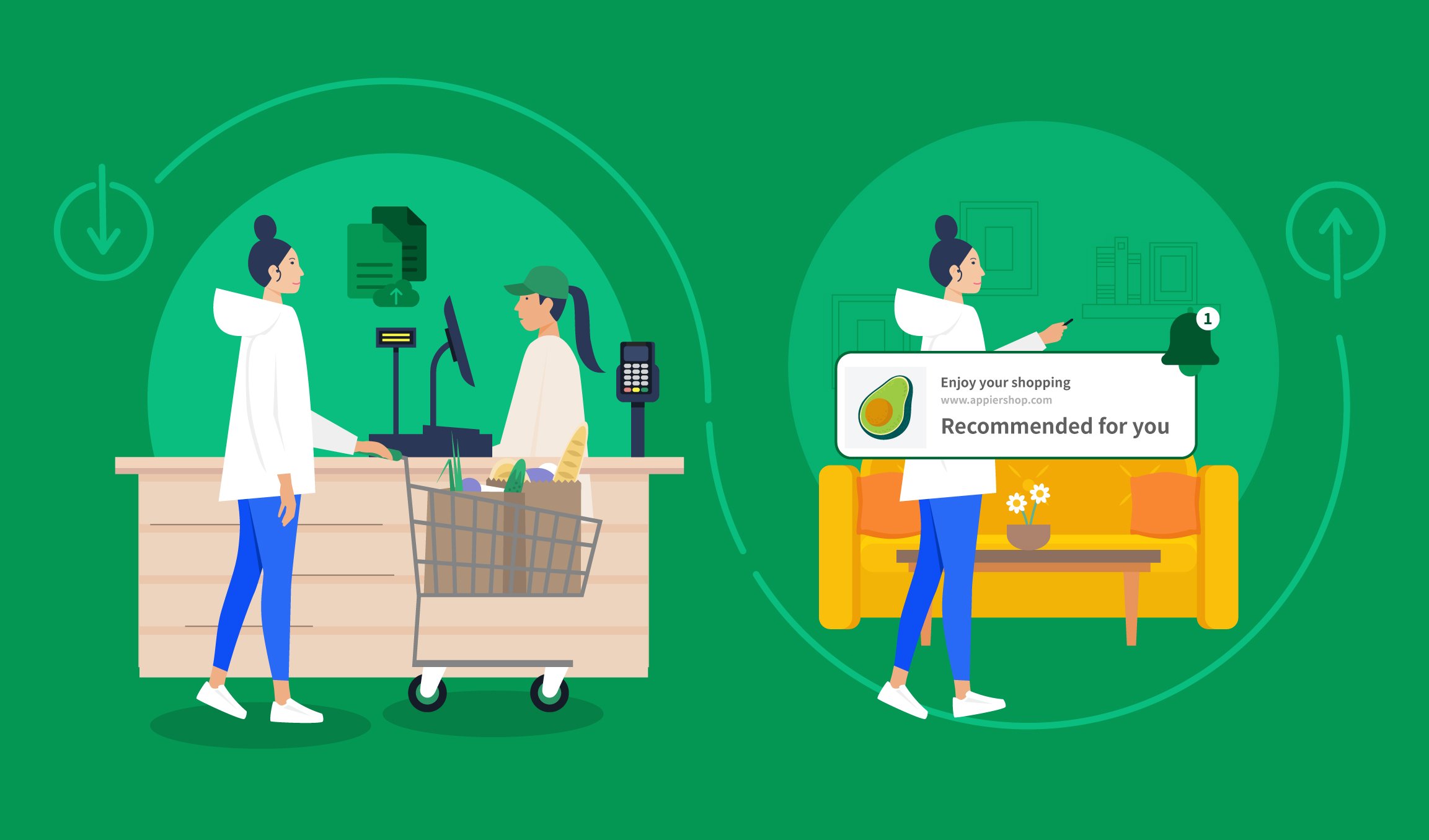
In “The Future of Retail Transaction Processing: Exploring Latest Trends,” discover the ever-evolving landscape of retail transaction processing and gain insight into the latest trends shaping the industry. As Detroit Retail Merchants navigate the changing market, it is crucial to stay informed and prepared for what lies ahead. By understanding what you need to know, you can adapt your approach and thrive in the dynamic world of retail.

The Rise of Mobile Payments
Mobile payments have revolutionized the way we make transactions in the retail industry. With the advent of mobile technology, people can now conveniently and securely make purchases using their smartphones or other mobile devices. This has eliminated the need to carry physical wallets or credit cards, making transactions faster and more convenient.
Contactless Payment
One of the key features of mobile payments is contactless payment. This allows you to simply tap your smartphone on a payment terminal to complete a transaction. With contactless payment, you no longer have to swipe your card or insert it into a card reader. This technology uses near-field communication (NFC) to transmit payment information securely between your device and the payment terminal.
Mobile Wallets
Mobile wallets have become increasingly popular, allowing you to store your credit card, debit card, and other payment information securely in your smartphone. These digital wallets provide a convenient and secure way to make payments, as they require authentication, such as a fingerprint or a PIN, to authorize transactions. Mobile wallets also offer the ability to store loyalty cards, coupons, and gift cards, eliminating the need to carry them physically.
Peer-to-Peer Payment
Mobile payments have also facilitated peer-to-peer (P2P) payments, allowing you to send money directly to friends and family using mobile apps. With P2P payment services, you can split bills, pay back borrowed money, or even send money internationally without the need for traditional banking methods. These services often make use of secure encryption and verification processes to ensure that your funds are transferred safely.
Biometric Authentication
Biometric authentication has become a popular security feature in mobile payments. This technology uses unique physical or behavioral characteristics, such as fingerprints or facial recognition, to verify your identity. With biometric authentication, you can be confident that only you can access and authorize transactions in your mobile wallet. This enhances security and eliminates the risk of unauthorized access to your payment information.
Blockchain Technology in Retail
Blockchain technology, originally developed for cryptocurrencies like Bitcoin, is now being adopted in retail for its ability to enhance security and transparency in transactions.
Secure and Transparent Transactions
The use of blockchain technology in retail enables secure and transparent transactions. Blockchain is a decentralized and distributed ledger that records and verifies transactions across multiple computers, making it virtually impossible to alter or tamper with transaction records. This provides an added layer of security and trust, as all parties involved can have access to the same information, ensuring transparency and reducing the risk of fraud.
Improved Supply Chain Management
Blockchain technology also offers significant advantages in supply chain management. By creating an immutable record of every transaction and movement of goods, it provides complete visibility across the supply chain. This allows retailers to track the origin, authenticity, and movement of products, improving transparency and reducing the risk of counterfeit goods. Blockchain can also streamline processes, such as inventory management and logistics, by automating the verification and transfer of ownership.
Customer Data Privacy
In an era of growing concerns over data privacy, blockchain offers a solution by providing greater control and protection over customer data. By using blockchain-based systems, retailers can give customers control over their personal information, allowing them to choose what data they share and with whom. This builds trust and improves customer confidence in the security and privacy practices of retailers, enhancing the overall customer experience.
Omnichannel Integration
Omnichannel integration is a strategy that brings together different sales and marketing channels to provide customers with a seamless and personalized experience.
Seamless Customer Experience
Omnichannel integration aims to provide customers with a seamless experience across all touchpoints, whether it be in-store, online, or through mobile devices. This means that customers can start their shopping journey on one channel and continue it on another with ease. For example, a customer can browse products online, add them to their cart, and then seamlessly transition to a physical store to try them on or make the final purchase. This integration eliminates the frustrations of disjointed experiences and ensures a consistent and delightful customer journey.
Inventory Management
Omnichannel integration also improves inventory management for retailers. By synchronizing inventory across all channels, retailers can avoid situations where a customer wants to purchase an item that is out of stock. With real-time inventory updates, retailers can ensure that products are available and ready for purchase, regardless of the channel used by the customer. This not only improves the shopping experience but also reduces the risk of lost sales and disappointed customers.
Unified Loyalty Programs
With omnichannel integration, retailers can unify their loyalty programs across all channels. This means that customers can earn and redeem loyalty points regardless of where they shop – in-store, online, or through mobile devices. Unified loyalty programs enable customers to have a seamless and consistent experience, regardless of the channel they choose to engage with the retailer. This fosters customer loyalty and encourages repeat purchases, ultimately driving revenue and building lasting relationships with customers.
Artificial Intelligence and Machine Learning
Artificial intelligence (AI) and machine learning (ML) technologies have vast implications in the retail industry, offering opportunities for personalization, automation, and improved customer service.
Personalized Recommendations
With AI and ML, retailers can provide personalized product recommendations based on customer preferences, browsing history, and purchase patterns. By analyzing vast amounts of data, these technologies can identify patterns and make accurate predictions about what products a customer is likely to be interested in. This allows retailers to deliver targeted and relevant recommendations, enhancing the customer experience and driving sales.
Virtual Personal Shoppers
AI-powered virtual personal shoppers are another exciting application in retail. These virtual assistants can interact with customers, answer questions, provide product recommendations, and offer personalized assistance throughout the shopping journey. Virtual personal shoppers use natural language processing and machine learning algorithms to understand and respond to customer queries, creating a more interactive and engaging shopping experience.
Fraud Detection
AI and ML can also be utilized to detect and prevent fraudulent activities in retail. By analyzing historical transaction data, these technologies can detect unusual or suspicious patterns that may indicate fraudulent behavior. Retailers can use AI-powered algorithms to continuously monitor transactions and flag any potential fraud risks in real time. This improves security and protects both retailers and customers from financial losses.

Voice Commerce
The rise of voice-activated assistants, like Amazon’s Alexa and Apple’s Siri, has opened up new possibilities for voice commerce in the retail industry.
Virtual Assistants
Virtual assistants powered by voice recognition technology allow customers to interact with retailers using their voice commands. Customers can make inquiries, search for products, and even make purchases by simply speaking to these virtual assistants. Virtual assistants provide a hands-free and convenient way to access information and make transactions, making it easier for customers to engage with retailers.
Voice-Activated Shopping
Voice-activated shopping takes the convenience of voice commerce a step further. Customers can use their voice to add products to their shopping carts, place orders, and make payments. This eliminates the need for manual input or navigation on screens, providing a seamless and effortless shopping experience. With voice-activated shopping, customers can complete their purchases quickly and efficiently, making it a valuable tool for busy individuals or those with limited mobility.
Augmented Reality in Retail
Augmented reality (AR) has become increasingly popular in retail, allowing customers to experience products in a virtual environment.
Virtual Fitting Rooms
One of the most exciting applications of AR in retail is virtual fitting rooms. Customers can use their smartphones or other AR-enabled devices to virtually try on clothes, accessories, or even makeup. AR technology projects the products onto the customer’s body, providing a realistic and immersive experience. Virtual fitting rooms enable customers to see how products look and fit before making a purchase, reducing the need for physical try-ons and enhancing the convenience of online shopping.
Product Visualization
AR also enables customers to visualize products in their own space before making a purchase. For example, customers can use their smartphones or tablets to project furniture or home décor items into their homes, allowing them to see how the products will look and fit in their desired space. This visualization feature enhances the online shopping experience, enabling customers to make more informed decisions and reducing the risk of returns or exchanges.
In-Store Navigation
AR can also be used for in-store navigation and wayfinding. Customers can use AR-enabled devices to display store maps, locate products, and receive personalized recommendations based on their preferences and past purchases. This technology enhances the in-store experience, making it easier and more efficient for customers to find what they need and discover new products.

Enhanced Payment Security
As technology advances, so do the methods used to protect payment information and prevent fraudulent activities.
Tokenization
Tokenization is a process that replaces sensitive payment information, such as credit card numbers, with a unique token. This token is then used for transactions, while the actual payment information is securely stored in a separate system. Tokenization adds an extra layer of security, as the token cannot be reverse-engineered to reveal the original payment details. This helps to protect customer payment information in case of a data breach.
End-to-End Encryption
End-to-end encryption ensures that payment information is securely transmitted and received between the customer, the retailer, and the payment processor. This encryption technology scrambles the data during transmission and can only be decrypted by the intended recipient. By implementing end-to-end encryption, retailers can prevent unauthorized access or interception of payment information, providing customers with peace of mind regarding the security of their transactions.
Fraud Detection and Prevention
Enhanced payment security features also include advanced fraud detection and prevention systems. These systems use AI and ML algorithms to analyze transaction data in real time and identify any potential fraudulent activities. By continuously monitoring transactions for suspicious patterns or anomalies, retailers can take proactive measures to prevent fraud and protect both themselves and their customers.
Subscription-Based Retail Models
Subscription-based retail models have gained popularity in recent years, allowing customers to subscribe to products or services instead of making one-time purchases.
Product Subscriptions
Product subscription models allow customers to receive products on a recurring basis, according to their preferences and needs. This model is commonly used for consumables, such as beauty and grooming products, meals, or pet supplies. By subscribing, customers can enjoy the convenience of receiving products regularly without the need for repeated ordering. This model also provides retailers with predictable revenue streams and the opportunity for more personalized customer experiences.
Membership Programs
Membership programs offer customers exclusive benefits and perks in exchange for a recurring fee. These programs can provide access to special discounts, free shipping, early access to new products, or personalized recommendations. By subscribing to a membership program, customers feel more connected and valued by the retailer, fostering loyalty and increasing customer retention.
Recurring Payments
Subscription-based models rely on recurring payments, which are automatically charged to the customer’s preferred payment method at regular intervals. This eliminates the need for customers to manually make payments each time, providing convenience and ensuring a seamless experience. Recurring payments can be managed through mobile apps or online platforms, allowing customers to have full control over their subscriptions and easily make changes or cancellations if needed.

Internet of Things (IoT) in Retail
The Internet of Things (IoT) refers to the network of interconnected physical devices and objects that can collect and exchange data.
Smart Shelves and Inventory Management
IoT technology enables the use of smart shelves and sensors to monitor inventory levels in real time. These smart shelves are equipped with sensors that can detect when products are running low and automatically trigger reordering processes. By constantly monitoring inventory levels, retailers can ensure that products are always available to meet customer demands, reducing the risk of stockouts and lost sales.
Connected Stores
IoT can also be used to create connected stores, where various devices and systems are integrated to provide a seamless and personalized shopping experience. For example, IoT devices can communicate with customers’ smartphones to send targeted promotions or personalized recommendations based on their location within the store. Connected stores enhance the overall shopping experience, providing customers with relevant information and offers at the right time and place.
Supply Chain Optimization
IoT technology offers significant benefits in optimizing the supply chain. By deploying IoT devices and sensors throughout the supply chain, retailers can collect real-time data on factors such as temperature, humidity, and location. This data helps to ensure quality control, reduces spoilage, and improves the efficiency of logistics operations. IoT-driven supply chain optimization also enables retailers to track and trace products throughout the entire journey, providing transparency and accountability.
Integration of Augmented Reality and Artificial Intelligence
The integration of augmented reality (AR) and artificial intelligence (AI) is a powerful combination that offers new possibilities for personalized shopping experiences.
Personalized Shopping Experience
By combining AR and AI technologies, retailers can create personalized shopping experiences tailored to individual customers. AR can be used to virtually showcase products in a personalized space, while AI algorithms analyze customer data to understand preferences and make targeted recommendations. This integration helps retailers deliver highly personalized experiences, increasing customer satisfaction and driving sales.
Virtual Try-On and Customization
The integration of AR and AI also enables virtual try-on and customization features. Customers can use AR to digitally try on clothing, accessories, or even furniture, allowing them to see how these products fit or look in their own environment. AI algorithms can analyze customer data to provide personalized recommendations for customization options, such as personalized engraving or color choices. This combination of AR and AI empowers customers to make informed decisions and creates a more engaging and interactive shopping experience.
In conclusion, the future of retail transaction processing is shaped by various technological advancements. Mobile payments, blockchain technology, omnichannel integration, artificial intelligence and machine learning, voice commerce, augmented reality, enhanced payment security, subscription-based retail models, and the Internet of Things are all playing significant roles in transforming the retail industry. By embracing these innovations, retailers can deliver enhanced customer experiences, optimize operations, and stay ahead in an increasingly competitive market.





Leave a Reply